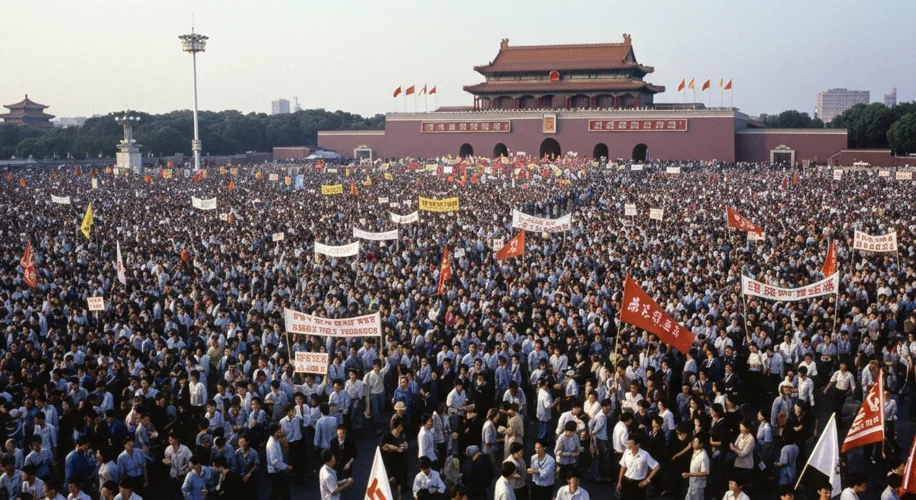The air in Beijing in the spring of 1989 was thick with anticipation. For weeks, Tiananmen Square, the vast heart of China’s capital, had become a crucible of hope and dissent. It began subtly, a ripple of grief following the death of Hu Yaobang, a reformist leader purged for his perceived leniency. But that ripple soon swelled into a torrent, drawing in students, intellectuals, and ordinary citizens alike, all yearning for a more open and just China.

The cultural backdrop was one of cautious optimism mixed with deep-seated frustration. China was in the midst of Deng Xiaoping’s economic reforms, which had brought a semblance of prosperity to many. Yet, this economic opening had not been matched by political liberalization. Corruption was rampant, inflation soared, and the disconnect between the ruling Communist Party and the aspirations of its people was growing wider by the day. The students, educated in a world increasingly connected by information, saw the hypocrisy and yearned for the freedoms enjoyed elsewhere.
The historical context is crucial. The late 1980s were a period of seismic shifts globally. The Soviet Union was unraveling, with popular movements challenging communist rule across Eastern Europe. The idea that authoritarian regimes were invincible was beginning to crumble. In China, however, the Party leadership was deeply wary of any challenge to its authority, remembering the chaos of the Cultural Revolution and fearing a similar descent into instability. This fear would become a defining element of the government’s response.
Central to the protests were the students, idealistic and articulate. Figures like Wu’er Kaixi and Wang Dan became prominent voices, articulating demands for greater democracy, freedom of speech, and an end to corruption. Their protests were largely peaceful, characterized by hunger strikes, impassioned speeches, and the construction of the “Goddess of Democracy” statue, a defiant symbol facing the portrait of Mao Zedong.
However, the key actors also included the hardliners within the Communist Party, led by Deng Xiaoping, who viewed the protests as a direct threat to the Party’s survival and the stability of the nation. They saw the students as a misguided mob, easily influenced by Western ideals and seeking to overthrow the socialist system. The ensuing crisis was a stark illustration of the deep ideological chasm within the Chinese leadership.
The events of June 3rd and 4th, 1989, remain etched in history with brutal clarity. After weeks of mounting tension, the People’s Liberation Army was mobilized. Under the cover of darkness, tanks and troops advanced into Beijing, their orders to clear the square and suppress the demonstrations by any means necessary. What followed was a tragedy. Accounts vary, but it is widely reported that soldiers fired indiscriminately on unarmed civilians, not just in the square but on the streets leading to it. The air filled with the sounds of gunfire, screams, and the rumble of tanks. The hopeful atmosphere of weeks prior dissolved into one of terror and bloodshed.

The consequences were profound and far-reaching. The immediate impact was a brutal crackdown on dissent within China. Thousands were arrested, many imprisoned, and a climate of fear descended. The international community largely condemned China’s actions, leading to widespread sanctions and a period of diplomatic isolation. The “Goddess of Democracy” fell, and the vibrant spirit of protest was seemingly extinguished. The event also solidified the CCP’s control, reinforcing the idea that stability, as defined by the Party, was paramount.
Internationally, the image of the lone protester standing before a tank became an enduring symbol of courage and defiance against overwhelming state power. It resonated globally, becoming a stark reminder of the human cost of authoritarianism. For China, the official narrative remains one of quelling a “counter-revolutionary riot,” a stark contrast to the lived experiences of those who participated or witnessed the events.
The analysis of Tiananmen Square is complex. Was it a missed opportunity for China to transition to a more democratic system? Or was the government’s response, however brutal, necessary to prevent the nation from descending into chaos, as seen in other parts of the world at the time? The event highlighted the inherent tension between economic reform and political control that has continued to define China’s trajectory. The memory of June 1989, though officially suppressed within China, continues to echo, a testament to the enduring human desire for freedom and dignity.

Even today, in 2025, the precise death toll remains unknown, a deliberate ambiguity that underscores the government’s continued efforts to control the narrative. The scars of Tiananmen run deep, a potent reminder of a moment when a generation of Chinese citizens dared to dream of a different future, and the violent reality that met their aspirations.

